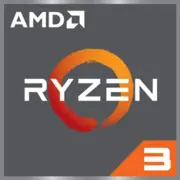AMD Ryzen 3 5300GE (OEM Only)

AMD Ryzen 3 5300GE (OEM Only): Budget Processor with Integrated Graphics for Compact Systems
Analysis of Relevance, Performance, and Use Cases in 2025
Key Features: Zen 2, 7nm, and Energy Efficiency
The AMD Ryzen 3 5300GE processor, released in 2021, remains a popular choice for OEM builds due to its balanced specifications:
- Architecture: Zen 2 (not to be confused with Zen 3 of the Ryzen 5000X series).
- Process Technology: 7nm FinFET from TSMC — an outdated but proven technology by 2025.
- Cores/Threads: 4/8, which provides multithreading for light tasks.
- Cache: 8 MB L3.
- TDP: 35 W — ideal for compact PCs.
- Graphics: Radeon Vega 6 (6 compute units, frequency up to 1700 MHz).
Key Features:
- Support for PCIe 3.0 (16 lanes).
- AMD Precision Boost 2 and SenseMI technologies for performance optimization.
- Low heat output — passive cooling is sufficient in Mini-ITX cases.
A practical example: In 2025, the processor is commonly found in ready-made office PCs (e.g., HP ProDesk 405 G8) and media centers due to quiet operation.
Compatible Motherboards: AM4 Socket and Nuances
The Ryzen 3 5300GE uses the AM4 socket, allowing for a wide range of motherboard options:
- Chipsets: A520 (budget), B550 (balanced), X570 (premium).
- Important: A BIOS update may be required for motherboards released before 2021 to ensure compatibility.
Selection Recommendations:
- For office tasks: ASUS Prime A520M-K (around $70).
- For multimedia: Gigabyte B550I AORUS PRO AX (Mini-ITX, Wi-Fi 6, $130).
- Avoid motherboards with weak VRM (e.g., MSI A320M-A PRO) — they won't provide stability under peak loads.
Memory: DDR4 and Dual Channel Mode
The processor supports DDR4 (not DDR5!) with a maximum frequency of 3200 MHz (up to 4000 MHz when overclocked).
- Recommended Size: 16 GB (2×8 GB) for multitasking.
- Example Configuration: Kingston Fury DDR4-3200 16GB — $50 (April 2025).
Important: Single-channel mode reduces integrated graphics performance by 20-30%.
Power Supply: Calculating with Margin
With a TDP of 35 W, the Ryzen 3 5300GE does not require a powerful power supply:
- Without a discrete graphics card: A 300 W PSU is sufficient (e.g., be quiet! Pure Power 11 300W — $45).
- With a graphics card of NVIDIA GTX 1650 level: 450 W (Corsair CX450 — $55).
Tip: Don't skimp on the PSU for OEM builds — low-quality units can cause issues with Vega 6.
Pros and Cons: Who is it Relevant for in 2025?
Pros:
- Energy efficiency: Consumes less power than the Intel Core i3-12100 (60 W).
- Integrated graphics: Vega 6 handles Full HD in Dota 2 (60 FPS on low settings).
- Low cost of OEM systems: Ready-made PCs based on 5300GE start from $400.
Cons:
- Only 4 cores: Outperformed by Ryzen 5 5600G (6/12) in rendering tasks.
- Lack of PCIe 4.0: Limits NVMe SSD speed.
- OEM Only: Not sold retail — hard to find for custom builds.
Use Cases: From Office to Streaming
1. Office Tasks: Document work, browsing (20+ tabs), Zoom — the processor remains unaffected.
2. Multimedia: 4K video streaming (Netflix, YouTube), decoding via HDMI 2.0.
3. Light Gaming: CS:GO (100 FPS on medium), GTA V (45-50 FPS on low).
4. Home Server: Energy efficiency + virtualization support.
Real Example: A PC based on the 5300GE + 16 GB RAM + 512 GB SSD — perfect for digital signage in stores.
Comparison with Competitors
- AMD Ryzen 5 3400G: 4/8, Vega 11, but on 12 nm (loses in energy efficiency). Price: $120 (used).
- Intel Core i3-12100: 4/8, UHD 730, PCIe 5.0. Better for single-threaded tasks, but more expensive ($130 new).
- Ryzen 3 5300GE: Wins on the basis of TDP 35 W and price of OEM systems.
Conclusion: For budget PCs without upgrades — 5300GE. For future upgrades — i3-12100.
Practical Building Tips
1. Cooling: The stock cooler will suffice, but for quieter operation, choose Noctua NH-L9a-AM4 ($45).
2. Storage: An SSD is a must (e.g., Kingston NV1 1TB — $60). An HDD will slow down the system.
3. Case: Mini-ITX (Cooler Master MasterBox NR200) or slim desktop (HP Slimline).
4. BIOS: Update via USB Flashback on compatible motherboards before installation.
Final Verdict: Who is the Ryzen 3 5300GE Suitable For?
This processor is an option for:
- Offices: Low power consumption + quiet operation.
- Media Centers: 4K HDR and compact design.
- Budget Gaming Systems: For undemanding games without a discrete graphics card.
Why in 2025? Despite the release of new models (e.g., Ryzen 3 7300GE on Zen 4), the 5300GE remains a cost-effective solution for ready-made systems priced up to $500. Its weaknesses (4 cores, PCIe 3.0) are offset by its price and availability in OEM offerings.
Basic
CPU Specifications
Memory Specifications
GPU Specifications
Miscellaneous
Share in social media
Or Link To Us
<a href="https://cputronic.com/en/cpu/amd-ryzen-3-5300ge-oem-only" target="_blank">AMD Ryzen 3 5300GE (OEM Only)</a>